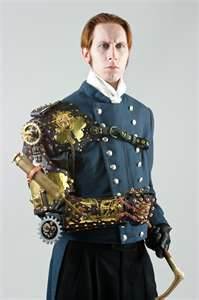Charles Babbage and probably one of the most reproduce Steampunk images

Charles Babbage, the father of Steampunk. It an unlikely parentage that might need a short explanation. Born in 1792, a time where the Industrial Revolution had just barely started; Trevethick's locomotive was 12 years away from being invented and Europe was yet to burn its last witch in 1811.
 Charles Babbage became a mathematician, a code breaker and mechanical engineer. In 1812 he was looking at a table of logarithms that he knew was full of mistakes. He devised an idea to break down the work into its simplest units of labor so unskilled computers could do the work (yes back then a computer was a person not a machine). This was the fist time the principals of mass production was used in computational work.
Charles Babbage became a mathematician, a code breaker and mechanical engineer. In 1812 he was looking at a table of logarithms that he knew was full of mistakes. He devised an idea to break down the work into its simplest units of labor so unskilled computers could do the work (yes back then a computer was a person not a machine). This was the fist time the principals of mass production was used in computational work.This was the beginning of another idea that machines can do the work of math and do it better than people. By 1822 he began work on what he called a Difference Engine. It was never built in his life time though some parts of it are on display at the Museum of the History of Science in Oxford England. The first Difference Engine would have been the most mechanically complex machine of its time. It would have had the basic architecture of the modern computer. The data and program memory was separated, operation was instruction-based, the control unit could make conditional jumps and it had a separate input / output unit. After ten years of work the British government pulled its funding for the project.
Above are two pictures of Difference Engine Number 2. Using Babbage's designs and Victorian period technology the people at the London Science Museum finished a working model in 1991 . Actually there are two copies of Diffidence Engine No. 2, one owned by the museum and another owned by tech millionaire Nathan Myhrvold. Both copies can complete seventh polynomial equations to 31 significant figures -which makes it a bit more powerful than a common pocket calculator but for the early 1800's this would have been just as revolutionary as the steam engine itself.
Difference Engine No.2 has about 25,000 parts, weights 15 tons and as you can see in the pictures it could easily fill up a room.
 The failure to complete the Difference Engine didn't stop Babbage. For years he sought private investors for a bigger and better machine and brought along this demonstrator model with him. This did square functions.
The failure to complete the Difference Engine didn't stop Babbage. For years he sought private investors for a bigger and better machine and brought along this demonstrator model with him. This did square functions.That bigger and better machine was the Analytical Engine. It had the advanced idea of using Jacquard punch cards (used in automatic looms) for programming. It would also had sequential control, branching and looping, and it could have been the first mechanical device that would have been Turing-complete. No one attempted to be this ambitious until the first electronic computers appeared a century later.
A group in Britain plan to construct the Analytical Engine and have it ready by 2021, the 150 anniversary of Charles Babbage's death. It is estimated it will have 675 bytes of memory and run at a clock speed of 7 Hz.
You can see the connection of all this to Steampunk. The big question of what if Babbage did succeed and the Information Revolution came right on the heels of the Industrial Revolution. A book by William Gibson and Bruce Sterling, titled the Difference Engine, speculated about an alternative history of the world where Charles Babbage's machines existed. And from that it caught on in its own niche of pop culture. The book was publish in 1990, a year before the London Science Museum completed Difference Engine No. 2.
It's interesting to try and imagine a world that could have been.
Above a Steampunk lab top computer. Below actual examples of Victorian gear craft and workmanship.
Charles Babbage may have the last word on this subject. Mechanical computing might seem like the ultimate anachronism but the University of California at Berkeley and DERA (Defense Evaluation & Research Agency) at Malvern England are both working on the newest generation of micro-electro-mechanical systems (MEMS). These are chips that have logic circuits with physical on-off switches on the nano scale. These circuits are more durable and able withstand environments of high heat and radiation.
I guess every good idea eventually finds its place in history.







No comments:
Post a Comment